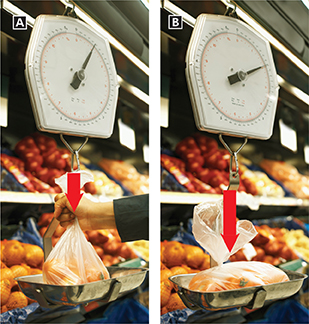Measuring Force
Forces are often easy to measure. In fact, if you've ever shopped at a grocery store, you may have measured forces using a spring scale like the one shown in Figure 2. The stretch of the spring in the scale depends on the amount of weight (a type of force) acting on it. As more fruit is placed on the scale, the spring is stretched farther and the scale reading increases.
Units of Force
Force is measured in newtons, abbreviated as N. One newton is the force that causes a 1-kilogram mass to accelerate at a rate of 1 meter per second each second (1 m/s2). In fact, 1 newton is equal to 1 kilogram-meter per second squared (1 N = 1 kg·m/s2). The newton is named after Sir Isaac Newton (1642–1727), the English scientist who explained how force, mass, and acceleration are related. You'll learn more about forces and mass in the next section.
 What amount of force accelerates a 1-kilogram mass at 1 m/s2?
What amount of force accelerates a 1-kilogram mass at 1 m/s2?
Representing Force
You can use an arrow to represent the direction and strength of a force. The direction of the arrow represents the direction of the force. The length of the arrow represents the strength, or magnitude, of the force.
In Figure 2, the force arrows represent the weight of the items on the scale. Both arrows point down because weight always acts downward. The lengths of the arrows show you that more weight acts on the scale in Figure 2B than the one in Figure 2A.
Combining Forces
Have you ever helped to push a car that has run out of gas? If you have, you were taking advantage of the fact that forces can be combined. The individual force of each person's push adds with the others into a larger force that allows you to move the car.
You can combine force arrows to show the result of how forces combine. That is, forces in the same direction add together and forces in opposite directions subtract from one another. The net force is the overall force acting on an object after all the forces are combined.

Figure 2 The downward force arrows represent the weight (a type of force) on the scales. The dial indicator gives a visual measure of the weight. Calculating What is the approximate weight difference between the two scale readings?




